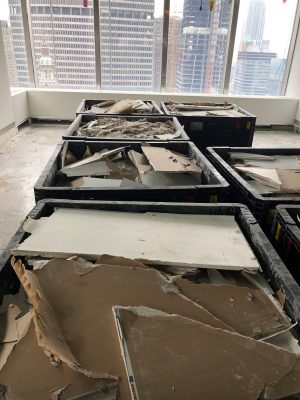Recycling construction and demolition waste is an ongoing global conversation. The following reflects current efforts as well as the concerns, challenges, and opportunities associated with recycling construction and demolition waste gypsum panels.
Gypsum panels currently incorporate recycled materials. Paper facers have been made from recycled paper for more than 50 years. According to one estimate, the gypsum industry annually recycles 40 million cubic yards of paper material into facers. Using flue gas desulfurization (FGD) gypsum in gypsum panel products is recognized by the EPA as an important contribution to sustainable materials management because it uses a non-hazardous secondary material, FGD gypsum, as a substitute for natural gypsum. Plant scrap and dunnage are also regularly returned to the manufacturing process.
Industry efforts to increase recycling by incorporating scrap from new construction is ongoing. New construction projects generate a significant amount of scrap gypsum board. An estimated 10 percent of the gypsum board necessary for a new building ends up as scrap. These cut-offs can be source separated on the job site to prevent contamination with other materials and sent to processors who remove the paper facers.
Once the paper facer is removed from gypsum board, the core, which is essentially gypsum, can be recycled as an additive to concrete, plaster, and stucco. The core material can be reused as a soil amendment, as a water treatment to settle suspended clay particles and added to animal bedding to absorb moisture. Research is being conducted on incorporating gypsum core into large scale composting efforts.
Manufacturers have strict requirements for incorporating clean scrap gypsum into new gypsum panels. The passive fire resistance gypsum panels provide in the built environment cannot be compromised. The existence of any residual paper fibers in the gypsum board processed for recycling limits the amount of recycled gypsum that can be included in new panels. Paper negatively impacts the fire rating. The separation of paper and construction site contaminants from clean gypsum board scrap is essential for manufacturers engaged in recycling efforts.
Despite the issue of paper fibers, “clean scrap” gypsum board is more readily recycled into new gypsum board than demolition waste. The process of demolition itself makes cross-contamination between various building material waste streams almost inevitable. Waste from demolition and renovation sites typically contain nails, tape, joint compound, scrap wood, metal, plaster, and paint. Significantly, structures built before 1978 may contain lead paint. To facilitate the safe recycling of clean scrap, GA staff and member companies led the development of ASTM C1881 – 20 Standard Guide for Closed-Loop Recycling of Scrap Gypsum Panel Products.
Recycling gypsum board from any source remains challenging but Gypsum Association member companies are committed to the wise stewardship of our shared resources.

